02-01: Ligno-cellulose â Resources
Trees are almost a constant presence in our lives. Even if the first image that one gets in mind when thinking on trees is a forest, we can find trees all over the farmlands (orchards, olive groves, windbreaks, etc.), along the river banks, and even as an integral part of towns and cities. Similarly wood, the main product of trees, is one of the most omnipresent elements of the human-made environment. Houses, furniture, tools, toys, paper products and many other things are made basically with wood. Along the process that takes from a standing tree to a table, a beam, or a book, an enormous amount of wood residues are produced. These residues are made available all over the landscape by the activities of forest harvest, farmland cultivation, sawmill and carpentry work, etc. and represent a formidable resource of fuel.
Furthermore, the recent technologies for wood transformation and combustion make any form of woody material (not just fuelwood logs) a very competitive source of renewable energy.
The challenge is however to estimate a real quantities of such resources available for valorisation in the certain area and in determined periods of time. The following text aims to provide some hints on how to assess those estimations.
02-01-01: Forest resources
Woody biomass has great potential to be obtained from different feedstock present throughout Europe. The prospective lie in relatively large area of European forests (nowadays there are 1.02 billion hectares) and increasing annual production rate of woody biomass. Nearly all European forests are covered by plans for their long term management. Volumes of wood harvested in Europeâs forests remain considerably below increment, so that the wood stock continues to increase. Over the last 20 years, the forest area has expanded in all European regions and has gained 0.8 million additional hectares each year. Over the same period, the total growing stock of forests in Europe has increased by 8.6 billion cubic meters (State of Europeâs Forests 2011).
It is rather impossible to provide detailed data regarding the available areas, volumes and growth rates for all European regions within framework of this manual. The reader is encouraged to follow the procedure of the available stock estimation as presented in chapter 02-00-03 case by case. However, a simple illustration of the potentially available biomass resources (roundwood production, harvestable roundwood and primary forestry residues) in several regions of EU according to Atlas of EU biomass potentials is presented in ktoe (kilo tones oil equivalent) on Figure 02-01 1. To convert the resources from "oil equivalents" into SI-units (TWh), divide the numbers by 85.985.
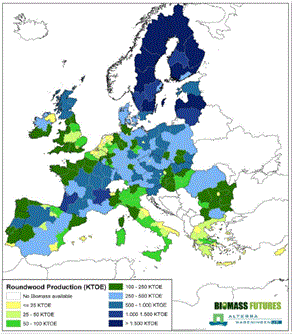
|

|

|
Figure 02-01 1: Upper left: Current round wood Upper right: Additional harvestable round wood Lower left: Primary forestry residues potential ktoe (source: www.biomassfutures.eu) To convert into TWh, divide by 85.985. |
Other valuable sources of information can be found in publications of Eurostat, FAO or scientific projects (such as Elobio, Biomass futures, and others). The local energy agencies and/or forest services should also be considered as the best source of up-to-data information.
In certain parts of the world the main sources of wood, lumber and biomass are specialized fast growing trees plantations (e.g. New Zealand). But there is no doubt that the main production of wood on a global level is strictly related to forests and trees communities ranging from natural to semi-natural formations.
It is also clear that the management of a natural resource, such as forests, must be done with the application of sustainable techniques. Given a certain growth rate, the very first rule to follow is that the extraction of biomass must be planned according to the growth rate of the trees population, and of course, the uptake must be less than the forest increment. This allows the continuous production of raw material without depleting the source. The same holds true for any woody assortments in general and specifically for the production of ligno-cellulosic biomass.
Current annual increment is a conceptual tool commonly used in forest planning and silviculture, and corresponds to the quantification of annual growth rate of the wood mass of a forest. As the woody mass is expressed in cubic meters of wood mass per hectare of land (m3 ha-1), the annual increment can be expressed in absolute values in terms of increase cubic meters of wood per hectare area within period of one year (m3 ha-1 year-1).
The growth rate of a natural or semi-natural forest can vary greatly according to species, site fertility, nutrients and water inputs, below are listed some examples:
• Mediterranean Garrigue or Boreal Taiga are examples of very unproductive forest ecosystems (average annual growth rate: 2 m3 ha-1 year-1);
• Norway spruce in fertile stands (lower Alps, Central Europe) can be considered as a common condition all over Europe (up to 10-12 m3 ha-1 year-1, rapidly decreasing for less fertile stands);
• Artificial conifer plantations on forest land can be an example of high productive semi-natural ecosystem (20 m3 ha-1 year-1 for young stands of Douglas fir on the Italian Apennines);
• Artificial plantations of fast growing species on agricultural land are the most productive system for the European conditions (40 m3 ha-1 year-1 for poplar and eucalyptus plantations in Southern Europe).
Please refer to chapter 02-00-02a for more detailed annual increment rates of forest within EU countries.
In a forest where all trees have the same age (such as an artificial plantation) the annual increase is not constant over the years, because the growth rate of young plants is faster that for old ones. In this case it can be useful to consider the average annual increment based on a certain time period (which can be extended to the whole life span of the plantation).
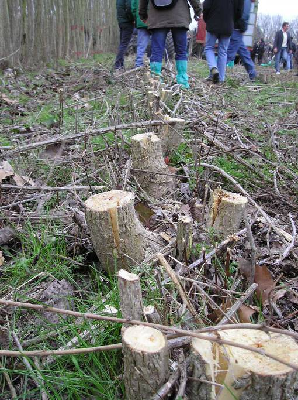
|
| Figure 02-01 2: Single row of freshly harvested poplar Populus sp. from short rotation forestry plantation (source: L. Casini). |
02-01-02: Limits to the forest resources
Currently, and hopefully for a long time to come, the dedicated production of biomass for energy is not economically viable, and forest biomass for energy is mainly produced from by-products of timber production and forest management operations. Probably the main exception to this statement is the production fuel-wood from broadleaves species, which in Europe is generally regarded as a traditional source of energy, not really competing with fossil fuels, but overlapping in the use (many country houses will have fireplaces or wood fired kitchen stoves coexisting with fossil fuels heating systems). As such, modern wood-based bioenergy systems are not directly endangering European forests health, but it is important to set limits and rules in order to assure the sustainability of such a use.
02-01-02a: Deforestation
The term "deforestation" indicates the total removal of forest cover on very large areas of primeval forests (or other natural forest ecosystems) in conditions that prevent the regeneration of the original ecosystem. Deforestation has been stimulated during the last decades by the growing demand of valuable timber in the international market. Such demand was often satisfied by means of illegal logging, performed with destructive techniques on sensitive ecosystems, without forest regeneration and in regions with little or no regulations for such forest activities.
Apart from timber production, deforestation can also be caused by slash-and-burn agriculture or other agricultural activities (such as grazing, but also soya bean cultivation in Amazonia).
In subsistence economies, fuel wood may be the only source of energy (mainly for cooking), causing deforestation localized in the surroundings of villages and settlements. In this case âbioenergyâ is a cause of deforestation, but it is related to a strictly local phenomenon.
In many countries, silvicultural treatments include clearcuts on large areas (i.e. removal of all standing trees), but in the frame of properly conducted forestry, natural and/or artificial regeneration is always accomplished according to local rules. In this case the deforestation is only temporary, and cannot be considered as damage in itself. Nevertheless caution should be paid to the preservation of soil fertility, essential for the sustainability of forest operations, and the necessary means of soil erosion control must be implemented in any forest operation.
02-01-02b: Forest soil nutrient balance and ash recirculation
With the extraction of any wood product from the forest, a certain amount of minerals bound to the wood will be subtracted from the local ecosystem (see table 01-01 1 in text section 01-01-01). Minerals are essential for the development of vegetal and animal beings, and enter in several ecological cycles as nutrients.
With the sole extraction of timber, the removal of nutrients can be considered negligible compared to the natural input of such minerals into the ecosystem, but when other tree parts are also extracted from the forest (whole small trees, branches, needles, etc.) the impact on the nutrient balance can be very important. In fact, compared to the timber (trunk), the other parts of the tree contain higher concentrations of nutrients, which will be accumulated as ashes after combustion (see table 01-01 2, section 01-01-02a).
Of similar importance is the soil content of organic matter. Before considering the option of residues removal, the stand fertility and resilience should be evaluated: biomass production is a sustainable practice in fertile stands, with high organic matter content, where the subtraction of nutrients and litterfall has negligible impact on the ecosystem balance.
An exception to the above statement can be given in Mediterranean forests, where the nutrient losses due to residues removal are preferable to the high nutrient and fertility losses due to forest fires: in this case the extraction of biomass is mainly a mean of fire control and, paradoxically, fertility protection.
Whenever possible, the nutrients extracted with the biomass and concentrated in combustion ashes should be returned to the original ecosystem. Considering a single household consuming wood in stoves, boilers or other appliances the amount of residual ashes produced will be negligible and such residues can be generally released into the natural ecosystem with no risk of pollution.
For larger industrial appliances, such as district heating, CHP and power plants, the amount of ashes produced is very large, and it must be disposed of paying attention to the possible environmental consequences. In this case one can distinguish grate (bottom) ashes and different classes of fly ashes (collected by the flue gas filtering systems). Grate ashes are generally considered as less harmful than fly ashes.
According to ash type and the local country regulations the ashes may be:
• disposed at landfill sites;
• returned to the forest (as the case of some grate ashes in Sweden);
or
• used for special purposes (steel industry, forest roads construction, etc.).
As an example (figure 02-02 3); in case of Italian district heating plants all ashes are land-filled, after being assigned with a specific waste code (according to the European Waste Catalogue). In most cases ashes from pure wood chips are assigned to code 10 01 01 (bottom ash) and to 10 01 03 (fly ash).
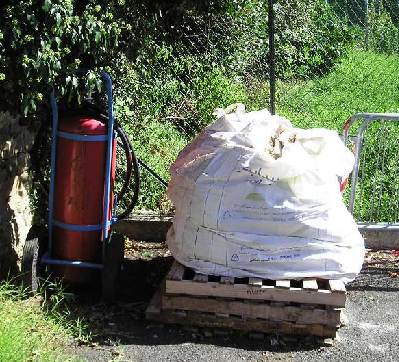
|
| Figure 02-01 3: Daily production of ashes of a small CHP plant ready to be disposed of (source: L. Casini) |
02-01-02c: Potential conflicts between timber industry and bio-energy
The new policy of EU aims to increase the share of bioenergy in the total energy production. As a result it is estimated that 20 % of the energy produced in Europe after 2020 will be from removable resources and around 80 % of the above will be related to ligno-cellulosic feedstock. At the same time an increase of production of wood-based products, including pulp, boards, furniture and others is expected.
As a consequence, even if today there is a balance between supply and demand of wood on the market, it will probably be not in equilibrium within coming years. Clearly, the critical factor for the resources distribution is related to prices and it has been observed in recent years that in some cases forest owners might get better price for round wood sold as biomass for energy rather than for pulp production.
Due to this competition the price of raw ligno-cellulosic biomasses rose from 60 to 150 % of the original values (between 2007 and 2009 in North America). Unfortunately, it might be possible that the demand for biomass would overtake supply and even more competition (and price raise) might occur by ~2020. The competition between energy and non-energy users of biomass (especially wood panel and pulp industries) is already emerging in several countries (such as Finland or Austria), and specific measures should be applied for avoiding the exasperation of a competition damaging both sectors.
Among others, possible ways to reduce the impact of negative competition could be to:
• optimize exploration of the forest and agricultural residues and make use of combustion appliances dimensioned and designed for using less valuable woody residues (stumps, branches, etc.) compared to the feedstock required for manufacture;
• increase share of recycled materials in the manufacture industry;
• encourage sustainable increase of SRF and SRC on agricultural and/or marginal land for the production of raw material both for energy and manufacture;
• increase the world trade of ligno-cellulosic biomasses from areas where the residues have limited or no market value (e.g. in tropical and sub-tropical countries wood residues have no use for heating but may even be a major disposal problem).
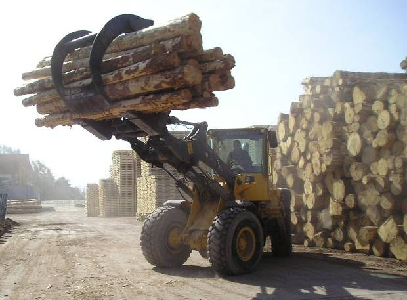
|
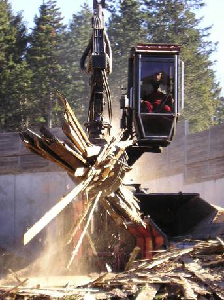
|
| Figure 02-01 4: Alternative resources for ligno-cellulosic residuals from wood industries; logs before processing in sawmill (a), sawmill residues in DHP (b) (source: L. Casini) | |
02-01-03: By-products from forest operations
The raw resource to be used for solid biofuel production (wood chips and/or pellets) will depend on the local market conditions and also on the organization/management of forest works.
The most important sources of by-products from forest operations and estimated yields are listed as below:
• Whole small trees produced in thinning operations (especially coniferous forest stands). In this case the whole product could be chipped, with an average yields of 40-70 m3 ha-1
• Whole adult trees from harvesting operations of mature stands of species with low or no market value (such as alder and birch in Central-Northern Europe or degraded chestnut coppice in Italy), again the whole output can be transformed by chipping, with an average yield of 200 - 500 m3 ha-1
• Forest slash (or brash) from final harvest of mature stands, in this case the main product is timber and the residual mass would represent ~10 to 30 % of the total yield, with 40-1000 m3 ha-1 of combined production (timber and residues)
• Woody vegetation removed in maintenance operations of river banks, from roadsides, from city parks, gardens and alike (100% of production)
In some countries (such as Finland and to a small extent Sweden) part of the belowground biomass (roots or stumps) may also be removed for energy. This use is however usually limited or forbidden in many European countries, (such as Italy) due to soil erosion control regulations. However, the removal of stumps is a common practice for field restoration in fast growing plantations on agricultural land and may thus represent a fuel resource.
02-01-04: Agricultural biomass
Agricultural ligno-cellulosic biomass might have higher potential for energetic use than forest biomass. This is especially true in the Mediterranean regions of Southern Europe where crops such as olive groves and vineyards are extremely common (Figure 02-02 5). Two different types of biomass might usually be considered:
• Pruning residues; provided with relatively low but constant (yearly) amounts of 1 to 6 green t ha-1
• Uprooting residues; collected at the end of the life cycle in quantities reaching in some cases 50 t ha-1
The overall quality of ligno-cellulosic biomass from the agricultural sector is rather low due to relatively high ash content, in fact pruning residues will have a high share of bark (typical of twigs and branches) while stumps, depending on the harvesting technology used, may have a high degree of soil contamination.
Another concern could be due to the presence of agrochemicals on the biomass surface and their influence on the flue gases emissions after combustion. However, recent studies seem to indicate that when comparing commonly managed vineyard residues to whole-tree forest chips (from spruce), the overall content of heavy metals is similar, and the resulting chimney emissions do not show important differences.
The main precaution to be taken when planning for the use of agricultural residues is to choose combustion technologies aimed for low quality fuels. This means that the equipment should be chosen among those dimensioned for forest slash, which is also considered a low quality biomass fuel.
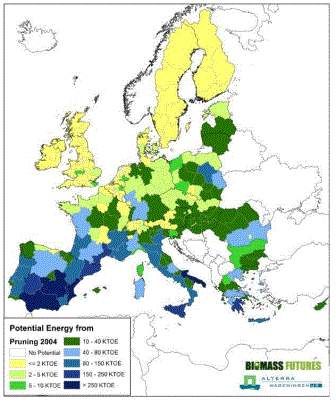
|
| Figure 02-01 5: Potential for energy production from woody residues
of fruit trees, nuts and berry plantations, olives, citrus and vineyards (KTOE) in 2004 (source:
www.biomassfutures.eu) To convert to SI-units, TWh, divide by 85.985. |
02-01-05: By-products from solid-wood industry
The by-products generated during industrial wood processing (wood chips, saw dust, slabs, trimmings, endings, veneer log cores, and so on) were traditionally used for particle board, fibre board and pulping.
Today, these resources are also considered an available source of fuel and/or for production of pellets. The biomass supply amount depends highly on the production level and the quantity of such residuals is estimated to be at the level of ~175 TWh (in the whole EU). However the detailed volumes and local availabilities have to be estimated case-by-case according to the proposed procedures described in chapter 02-00.
A possible source for collection of residual biomasses is the local wood industry with the highest potential allocated in the sawmill sector. However, other manufacturers of value added wood products (such as joineries, wooden house fabrications, furniture, windows, etc.) might also provide residuals or by-products for energetic conversion.
The ratio of residues to the total quantity of timber consumed in the sawmill industry is very variable. It depends on the technology applied (band saws, circular saws, frame saws) but also on the typology of products, and on the raw materials quality/size and handling.
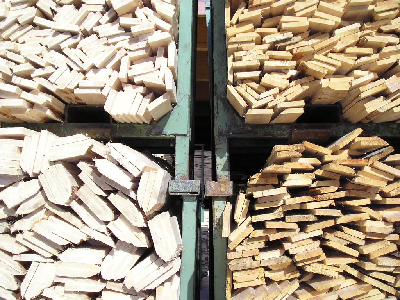
|
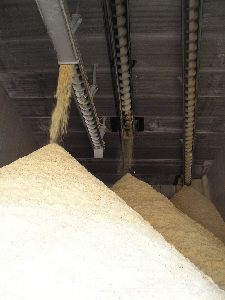
|

|
| Figure 02-01 6: Examples of various wooden commodities; Left: The products (packaging wood slabs), Middle: Waste #1 â sawdust, Right: Waste #2 â chips (source L. Casini, sawmill in Fondo, Trentino) | ||
There is a clear tendency to reduce the waste production of sawmills by applying thinner saws, scanners and cutting optimization techniques since the raw material costs in sawmill operations might represent up to 80 % of total costs. Therefore, an estimated value of the available biomass ranges within 20 to 55 % of the input volume of logs.
A dedicated study in the Alpine Region (Trento Province) has been conducted to illustrate the quantities of wooden wastes generated by sawmills (the total number of sawmills studied was 105). The total amount or residuals was estimated as ~580 000 m3 and detailed results are summarized in figure below:
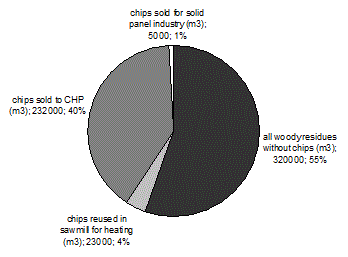
|
||
| Figure 02-01 7: Share of sawmillâs residual (volumes) provided to the market in Trentino including chips sold to CHP | ||
It should be also mentioned here that the relatively small share of chips reused for internal heat production in Italian sawmills might be significantly different in other regions. In general however, most of the wood industries have already realized the potential of woody wastes and by-products for utilization in internal energetic purposes or as a source of additional income in form of selling pellets and/or briquettes.
Another important remark is that some production woody wastes are not usable for the energetic transformation. For instance, in some countries the residues from joineries are not classifiable as biomass according to the local regulations because they are a mixed with other waste fractions. As a consequence their energy use is forbidden.
Today in Italy, for example, the biofuel supply to most energy plants is provided using locally produced wood chips, in the regime of regulated and controlled forest harvesting, and sanctioned in case of crimes. The local supply, which in some respects corresponds to the so-called short-supply-chain, is generally well suited for small-medium sized plants, resulting in positive conditions of transparency of information and ease of external control.
In the case of large power plants fuelled with wood-chip the annual demand becomes very large, and is very unlikely to be satisfied with only local resources. Thus the relation with the local territory is reduced (or nullified); the biomass is collected in a very large area, including distant origins complicating traceability. The longer-distance transports may be always considered, even if transportation cost of biomasses is higher than of fossil fuels. In consequence an approach of building several smaller bio-energy plants close to the continuous/sustainable source of biomass should be considered as an alternative for large scale plants.
02-01-06: By-products from other wood industry
Several other wood industries such as fibreboard, particle board, oriented strand board, medium density fibreboard or plywood are rather well established. Most work on the basis of very precisely developed technological processes and well managed waste management. It is impossible to provide detailed figures of available biomasses. The estimation of the bio-resources must be based on case by case studies.
In analogy to above, the pulp & paper industries are producers of great amounts of bio-residuals and wastes. Even if these could be converted in to energy (not only by combustion but also due to anaerobic digestion) the access for such resources is very limited. The technological process itself usually includes the waste management and transformation. Again, the estimation of the available bio-resources should be based on individual studies.
02-01-07: Planning aspects
Considering the variety of possible sources of woody biomass , when setting out for planning a new bio-energy system the first step to take is to perform a very detailed and comprehensive inventory of the present (or potential) sources of biomass in the surrounding territory; the area to be considered will increase according to the hypothetical boiler size. The first thing in the survey should be to look at the total, regional, forest resources in combination with the regional forest-based industry. On that base a supply scheme that is not in a competition with other local industries, might be set up. Once that is done, one should also look at non-forest resources, such as by-products from agricultural activities, societal activities and alike and include also these resources.
Forests will be the first basin to consider, but in some cases biomass production could be in competition with other uses, be limited by intrinsic environmental fragility or other constrains. Major contribution might be given by wood industry, agriculture land and/or by any other of the above mentioned sources of woody residues and it is therefore necessary to consider an integrated production system. This previous analysis is of the outmost importance for a number of reasons:
• The long term availability
The long term availability of fuel for the appliance planned is an essential factor for its economic and environmental sustainability. It is also important to evaluate the biomass availability over time, considering both the whole duration of the investment (generally speaking about two decades) and the yearly variations (i.e. forest and agricultural operations may be restricted to a specific season, thus the year-round procurement will need specific devices). The optional import of fuel by means of rails, trucks or ships should also not be omitted. If the long term availability of fuel cannot be accomplished the project might need to be seriously re-considered.
• The quality of the fuel
The quality of the fuel, at least for the main sources, should be carefully considered as well its variations over time (e.g. drier in summertime). The energy conversion technology, feeding system, and all the plant elements must be chosen according to the result of this analysis: the selection of an excellent boiler but inappropriate for the specific fuel available in the region may well lead to a project failure (e.g. a very common wood chips boiler, designed for the combustion of debarked sawmill residues, will have very poor performances with agricultural pruning residues, and also with forest slash);
• Local opportunities
Local opportunities may be extremely important. For instance, any disposal or management problem related to woody biomasses in sectors not involved (yet) in bioenergy can be an excellent basis for a robust and economic supply chain based on a mutual benefit. An example may be given by most woody agricultural residues, which represent a disposal problem for farmers and are often piled and combusted in the field. A furnace capable of consuming such material could provide an alternative for farmers (cheap and environmentally friendly) while relying on a competition-free and economic source of fuel.
References
Aya Uslu, Natalia Caldes Gomez, Marta Santamaria Belda, Demand of lignocellulosic biomass in Europe, Elobio project, Intelligent Energy
Hetsch S, Potential sustainable wood supply in Europe, UNECE-FAO, 2008
Berien Elbersen, Igor Startisky, Geerten Hengeveld, Mart-Jan, Schelhaas & Han Naeff, Hannes Böttcher, Atlas of EU biomass potentials, www.biomassfutures.eu